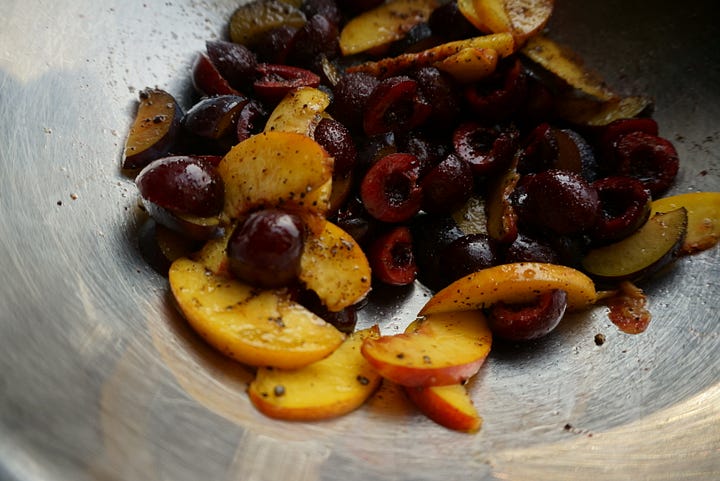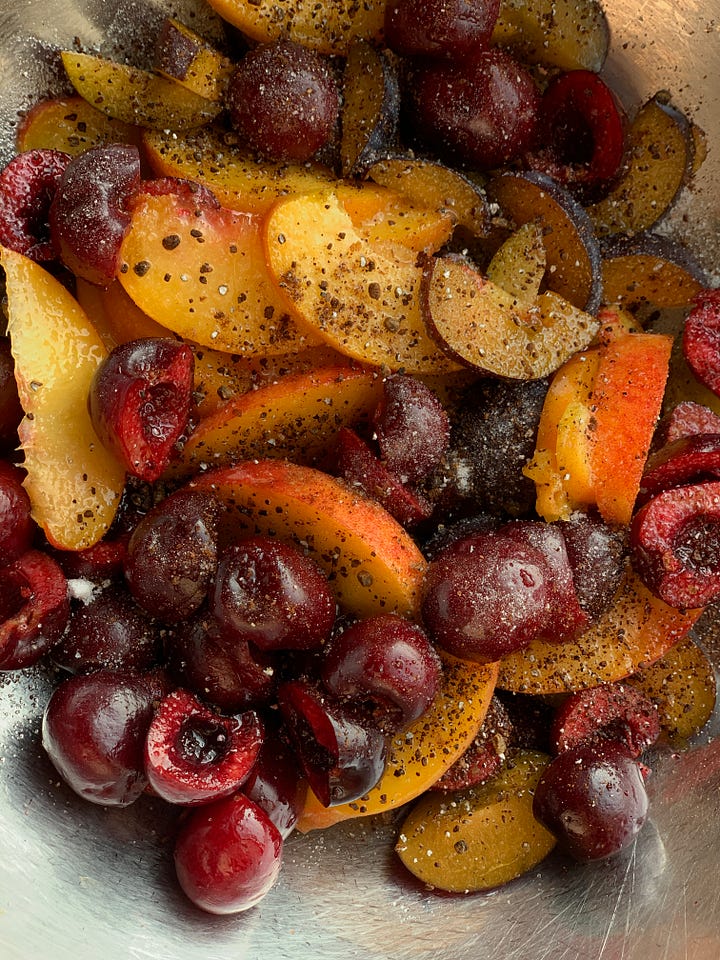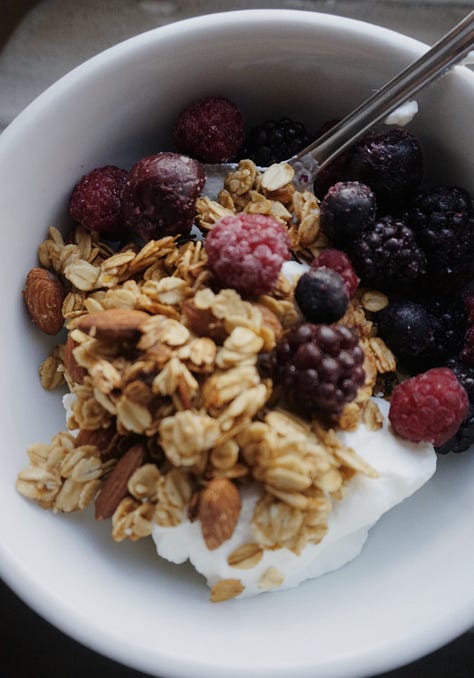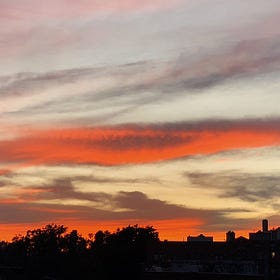Slow Bloom
Plums on Leaves, and The Mouth of Spring (The Fruit of Possibility is a Many Petalled Flower)
As the season grows, teaching is expanding: sign up for workshops in NYC + Chicago in April. Flow with ink, breath, wonder, paper in an upcoming class. To start, strengthen, or sustain a creative journaling or meditation practice, try a virtual 1:1 session. As always, listen to these essays here, and pair your creative practice with a journal or card from Odette Press.
Plums ready in buds on the tree ends. Tiny, bright, green.
I only know they are plums because of what I saw as I ran past them in the months of summer last year — July, August, September, there along my familiar path, watching the fruit unfold. Deep purple, ripe on the branches, the fruit confirmed their names and their tastes as the season bloomed.
Where I live in the city there are fruit trees seemingly everywhere: fig tree and plum, pear and tart cherry, mostly nestled into yards, guarded and tucked into corners, protected by fences from the eager hands of passing neighbors. These fruiting trees, quiet and dormant in Winter, and only begin reveal themselves in their fullness after the application of time, and light, and the season. Then, see: we know their names, their tastes, what grows from the seeds, we know what the trees contain.
Blooms burst, bright. From the soil that slopes along the lines by the park green starts to push through the grayed ground. Standing at the edge of the park, I watch how color carpets the wintered ground. First green bright soft grass on the park earth, it covers the moment with wonder, the soil warming, ground like velvet, showing signs of the unfolding season.
It will take the nearby plums all season, and into Summer, to form, but there they reside, all leaves on the edges of the branches, slowly blooming, and every stage they are still plum. Summer months will grow, because the Earth does not stop in motion, and days give us sunlight and chances for repetition. Trees will flower, fruit, then Summer sun will blaze through, sunlight a honey light pouring warmed and slowly into the hours, day hazy, fruit perspiring, glittering with specks of water, as our skin will, too. The fruit growing, the fruit holding water, the plum still a plum no matter what stage it is.
At the beginning of a day, a practice, a session for writing or breathing, I make all attempts I can to give myself good ground. An intention, a task or aim done with the embodiment of heart, is planted in the actions we take, the soil of our lives, our ground. Lately I try to make space in the soil of my life; clear away debris, the accumulation of harsh thoughts, dropping down into the compassion of the body, and I am writing to you about plums, but more, about the idea of growing, and opening: about noticing, about potential, about the boundaries that hold us close to ourselves, and the ways we nurture ourselves so as to bloom and unfold. About the seeds we plant in the soil, as in intention, aim, or idea, and the many dedicated efforts it takes to bring something to form, or fruition.
“Mindfulness is loving all the details of our lives,” writes Pema Chödrön “and awareness is the natural thing that happens: life begins to open up, and you realize that you’re always standing at the center of the world.” A plum tree has the basic energy of plum, and does not try to be anything but plum, and within ourselves, as humans, we understand that we contain the seed of understanding and instinct, a basic goodness, a basic impulse to grow, and that it is possible, given the right timing, temperature, and environment. A practice, of any kind, requires repetitions: a sense of returning and endurance, and anything growing grows in revisiting, and asks for a trusting our basic goodness, trusting that whatever is contained within us is on our side, is useful, is full of sweet ripe fruit. Chödrön continues on to say “the message is that each of us has all that it takes to become fully enlightened. We have basic energy coursing through us.”
My earliest memories of stone fruit, or rather, the images that are most vivid and palpable, are hot summers drenched in cold peach ice cream; picking plums on the Eastern Shore of Maryland, eating them almost upside down on the grass with close-to-family friends, picking peaches in my twenties in the aftermath of my mother’s mother’s death. All light, this fruit, grown from soil, water, heat. We’d reach up and take our hands and take the fruit from the trees, a ritual to honor the woman who taught us to pick strawberries, peaches, tomatoes, and the seasons, and how to preserve them. How sometimes we need jar or seed or shell or some harder outer layer to let ourselves float, out of rest or threat or preservation.


Last August, in the hot days leading to my thirty third birthday, I took a handful of cash to the fruit stand on the corner. I took the cash, exchanged it for a clear plastic bag filled with the soft weight of readied fruit. I picked out peaches, plums, cherries, holding each one by the handful, as if they were minutes in a day — precious — remembering the nearby plum tree. Back in my kitchen, covered in sweat, I halved the fruit, removed the pit, soaking them in a mixture of vanilla, coffee, sumac, arranged as a celebration in the growing circle of the tart shell.
The longer I learn to sit with life, the more tender I become, which is the goal of the practice: not to eradicate harshness, not to only feel delight of the cherished sun, but to become familiar enough with life to let it all unfold. Repetition, done slowly, yields an opening, but opening can only happen if we, like the seed, receive the deep, nourishing care and support we need to feel safe to unfold. We open, and close, out of nourishment or respect for ourselves, leaning into the potential of seed that remains in a hard, inner shell until something comes along and nourishes it, and warms it, which is to say, loves it well enough to open. Warm ground, sunlight, nutrients, with practice we learn to find ourselves at the center, and unfold as if bloom or fruit, growing, and opening, and radiating out.
Time, soil, rain, sun: all ingredients in the process of growing. It’s not a matter of if the plum contains the ability to be a plum; we understand it is plum at its essence. It is, rather, how. On the note of a different tree, Marie-Louise von Franz writes,
“The seed of a mountain pine contains the whole future tree in latent form; but there are a number of special factors, such as the quality of the soil and the stones, the slope of the land, and its exposure to sun and wind. The latent totality of the pine in the seed reacts to these circumstances by avoiding the stones and inclining toward the sun, with the results that the tree’s growth is shaped. Thus an individual pine slowly comes into existence, continuing the fulfillment of its totality, its emergence into the realm of reality. Without the living tree, the image of the pine is only a possibility or an abstract idea.”
From the center of the tree, contains the whole encoded information about what it means to become fruit. A plum is a plum, and “...right in our heart is everything anyone could wish for in terms of open, courageous warmth and clarity. Everybody has it, but not everybody has the courage to let it ripen…These days the world really needs people who are willing to let their hearts, their bodhicitta, ripen,” Chödrön continues, and pema in Tibetan Buddhism is a flower, a lotus, representing wisdom, one that grows from the mud — a transmutation of that which afflicts and seeks to destroy turned instead into the bud, the bloom, something wise.
Peach ice cream drips down aging memories from the summers, but the memory of sweetness remains, preserved somewhere in the body, mind, psyche, felt and sensed with stillness, slowness, writing, breathing. There have been times where I have sought to escape from myself, and in times of stress or perceived pain, there are many moments where we choose to cover ourselves over, to encase ourselves with something hard, as in jar, as in outer casing of sound or seed so as for protection. Still, we find ourselves with all encased potential as if peach stone, or plum pit; it is about finding, prioritizing, the people and the places and the states of being that allow us to grow. Continuing on, von Franz writes that “[a tree] does not get annoyed when its growth is obstructed by a stone, nor does it make plans about how to overcome the obstacles. It merely tries to feel whether it should grow more toward the left or the right, toward the slope or away from it”. This growth process is a creative force, one that asks for the steady dedication, as in meditation, of revisiting, of refining, of dedication, of repeating, of arriving ourselves and each other to the places of holding, of tending, of being, of rooting, and allowing: allowing ourselves to unfold.
One night, recently, winding down before passing through the threshold into sleep, I considered how astonishing life is. I am clear eyed as I write this, present to the fact that there is cruelty, and brutality, and heartbreak; that there is blood where there should be blossoms, that headlines that are devastating. But the seed I plant is one where the joy I cultivated is sacred, an honoring of the ritual that is now moment, this time, and one that I fight for, cultivate, and refuse to give that away. I trace a perimeter around myself, and I look out, and breathe, and find myself at the center. I see with clarity the decay, the destruction, and it breaks my heart, and in doing so, shows me the terrain around which I assert a refusal: a circle around my own boundary, a seed around my joy, a steady and stable encasing. The breaking is one of down, into the ground and the soil, so as to break open, then up, and through; one of rooting into the soil of loving. A place to hold. A moment for growing.
We each start from a mystery, then travel the distance, miraculously, into the land of the living. From the tiniest seed of poppy, starlight, plum, grows the roots and the stalk and the stem of the tree, rooting down and rising up, ripe with continuity. From some tiny seed, anything small can grow in the right environment, stretched out across time, fed to the root with the right time, the right ingredients.
There are times when we try to escape ourselves, or harsh, or cover ourselves so as to preserve ourselves. We guard, we stone, we harden; we encase ourselves, so as to protect ourselves from the suffering of the world. Yet the casing keeps us closed off from the seed of softness, the tender heart opening, the soft flower blooming. Still, we find ourselves with all encased potential as if peach stone, or plum pit. Still, there is some guiding force in each of us: some impulse of continuity, paired with the ingredients of our essence and the passing of time, that, like season, drives us forward.
I used to try to escape. Instead, now, I curl in. I turn toward myself, on an evening alone, encased in the quiet calm of my own silence. I gather breath, body, heart, mind, attention, all together, turning in as if a seed into myself — an experience where the tears are rain, water, softening the heart, and they rain down, and I remember the ways we all contain our own lines, roots, knowing, sensing, unfurling, in these wise minds and bodies. It’s a matter of rooting down, nurturing, and listening.



Buddhism talks a lot about accumulations and the ways, through practice and learning to be with, we uncover ourselves. It’s vulnerable; it’s seed unfolding; it’s revealing and confronting, at times, seeing our lives and our habituations up closely. But beyond that is a softening, whereby you may at times touch into that soft center, that is in fact very strong: the place within you — heart, stomach, mouth, centers — that open, so that the frequency of your body opens and opens and opens, radiating out and open and through.
When something is new, as in beginner, as in leaves unfolding on the edges of the fruit trees, this new growth often feels unfamiliar — bird stepping out on its shaking legs, not yet knowing wings, or understanding strength of instinct. But possibility is a many petalled flower, and almost all things contain the potential to bloom. We recognize that each of us is at our core in some way to be soft and tender.
It’s Spring now, and warming enough to let the grass and trees grow. Flowers open slow and wide, buds open as if mouth. The neighbor’s fig tree, no doubt like the far neighbors’ plums, show the first signs of growing. Figs look like little teeth on the edges of the branches, emerging slowing after preciously being cut back at the end of the last years’ season, and in months to come, hands will pull the fruit from trees into bowls, maybe, baskets, and mouths will open, and fruit will fall toward the ground letting us know that gravity, and the season, despite everything, is still working, returning to seed.
All the fruit is already contained within the tree, and a tree could start as starlight, grown in the circle of the moon before becoming fruit, cut up and placed in the circle of a bowl, brought to delight at the portal of your mouth. A seed becomes a tree, then from the ends of the tree buds form, then leaves, then the cyclical unfolding of fruit. “In many traditions,” writes Pema Chödrön, “the circle is a powerful symbol for the sacredness of all things. Throughout these traditions, there are rituals in which the image of the circle is used like this: by drawing a circle around yourself and standing in the middle of it, you realize that you are always at the center of the universe. The circle that surrounds you shows you that you’re always in the sacred space.”
A dot, a star, the moon, a circle, a seed, a line, a plum cut up and put together in a bowl months from now. Like a plum blossom, an idea is stunning: starting from a single point, growing, picked from the trees, sliced and coated in sugar, gathered into bowls, baked into tart shells, then shared, and radiating out. Perhaps what I am trying to write is a reminder of continuity: that the season keeps going.
Nourished By, Nourishing:
Date, sumac, orange cinnamon rolls for a Sunday breakfast, and the gradual radial opening of the plants and birdcalls. Reading A Man and His Symbols by Carl Jung, as quoted from above, along with The Wisdom of No Escape by Pema Chödrön. Opening to the season slowly. Listen here, for a playlist for March.








